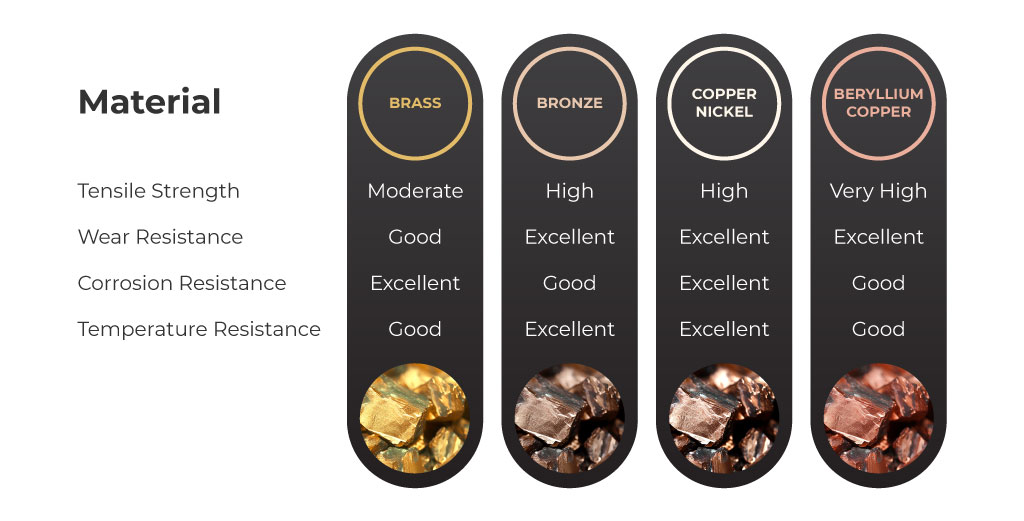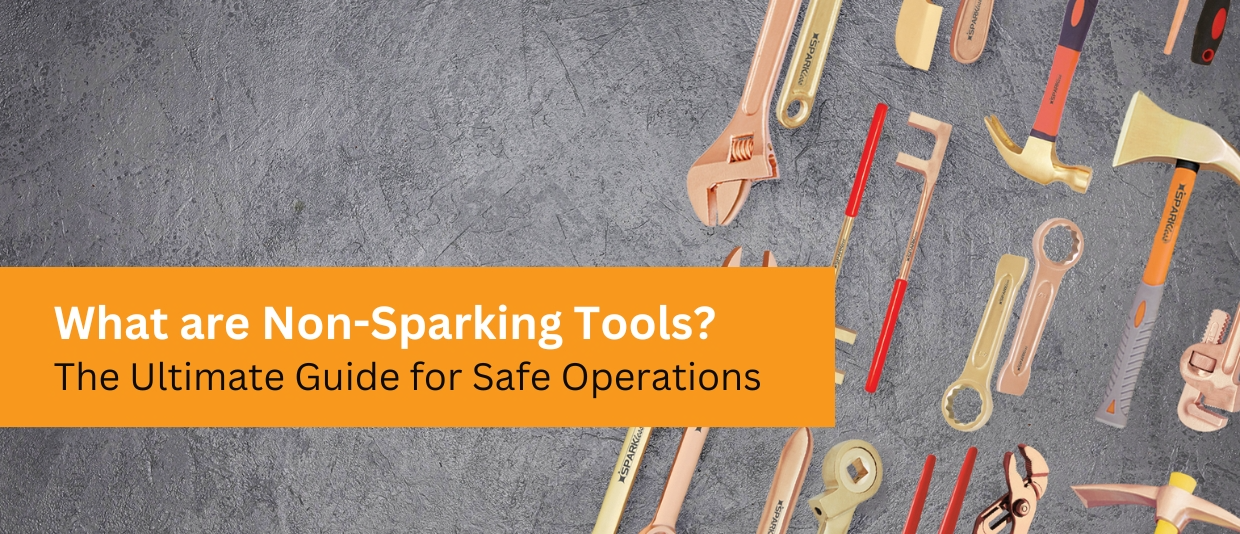
What are Non-Sparking Tools? The Ultimate Guide for Safe Operations
| Key Takeaway | Description |
|---|---|
| Prioritize Safety | Recognize the critical importance of using non-sparking tools in hazardous environments and make safety a top priority in all operations. |
| Select Certified Tools | Use only certified non-sparking tools that comply with recognized industry standards, ensuring they meet the necessary safety and performance requirements. |
| Implement Best Practices | Adhere to best practices and safety protocols, including proper training, risk assessments, permit-to-work systems, and emergency response planning. |
| Maintain and Inspect Tools | Regularly inspect, clean, and maintain non-sparking tools to ensure they remain in optimal condition and free from damage or wear that could compromise their effectiveness. |
| Follow Manufacturer Guidelines | Strictly follow the manufacturer's guidelines and instructions for the proper use, maintenance, and care of non-sparking tools. |
| Foster a Safety Culture | Cultivate a strong safety culture within your organization, encouraging open communication, continuous improvement, and a proactive approach to risk management. |
Introduction
Non-Sparking tools are specialized hand tools designed to prevent the ignition of flammable materials, vapors, or gases in hazardous environments. These tools are usually constructed from non-ferrous metals or non-metallic materials that minimize the risk of generating frictional sparks, which could potentially cause devastating explosions or fires.
Working in industries such as oil and gas, chemical processing, refineries, and other areas where flammable substances are present requires stringent safety measures. Using regular steel tools in these environments can be extremely dangerous, as the friction or impact between the tool and the work surface can create sparks, leading to catastrophic consequences.
Non-Sparking tools play a vital role in mitigating these risks, ensuring the safety of workers and the integrity of the operations. By understanding the importance of non-sparking tools and following proper safety protocols, companies can significantly reduce the likelihood of incidents and protect their employees, assets, and the environment.
In this comprehensive guide, we will delve into the world of non-sparking tools, covering their definitions, materials, applications, safety considerations, industry standards, and best practices for their proper use and maintenance.
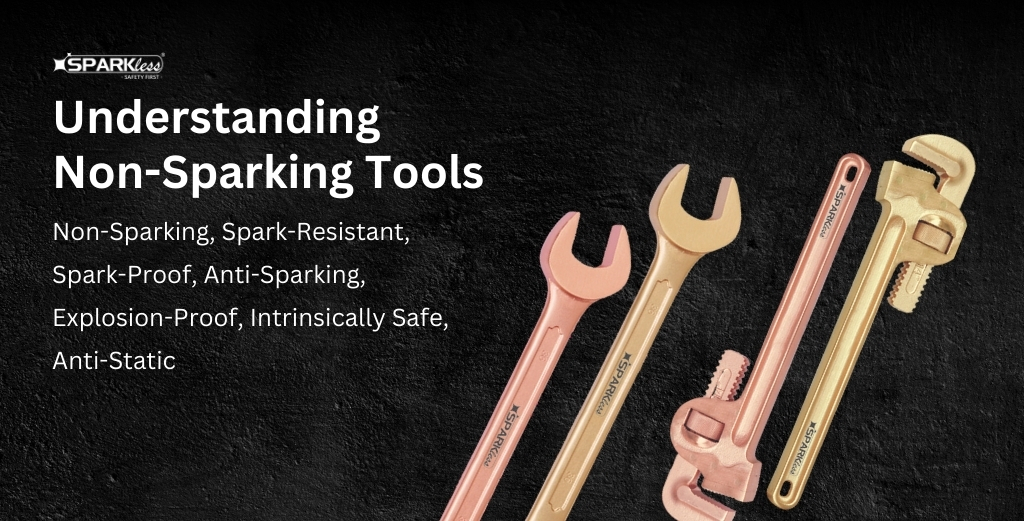
1. Understanding Non-Sparking Tools
When working in hazardous environments, it's crucial to understand the terminology surrounding non-sparking tools and the potential risks associated with using regular tools. In this section, we'll clarify the different terms used and dispel any misconceptions.
a. Defining different terms: non-sparking, spark-resistant, spark-proof, anti-sparking, explosion-proof, intrinsically safe, anti-static, Ex
- Non-sparking tools / spark-resistant tools / anti-sparking tools: These tools are designed and constructed to minimize the risk of generating incendiary sparks during normal use. They are typically made from non-ferrous metals or non-metallic materials that are less likely to create sparks when struck against other surfaces.
- Spark-proof tools: This term is often used interchangeably with non-sparking tools, but it's important to note that no tool can be considered truly "spark-proof" under all circumstances. Even non-sparking tools can produce cold sparks or sparks under extreme conditions, such as high-speed impacts or excessive force.
- Explosion-proof / Intrinsically-Safe: This term usually refers to (electrical) equipment designed to prevent sparks from circuits igniting the hazardous atmosphere in which they operate. From a tools perspective, non-sparking tools do not have their own source of ignition. Since non-sparking tools are unlikely to create sparks they are termed explosion-proof/intrinsically-safe.
- Anti-static: Usually refers to equipment that prevents build-up for static charge (ESD). This equipment usually dissipates static electricity or inhibits its build-up. Once again non-sparking tools are not necessarily anti-static but when users ask for tools that are anti-static they are alluding to non-sparking tools
b. Clarify the misconception about being "truly non-sparking"
While non-sparking tools are designed to minimize the risk of sparks, it's essential to understand that no tool can be considered 100% spark-proof under all conditions. Even the best non-sparking tools can potentially produce cold sparks or sparks if used improperly or subjected to extreme forces.
The term "non-sparking" refers to the tool's ability to significantly reduce the likelihood of generating incendiary sparks during normal use and under typical conditions. However, it's important to follow proper safety protocols, use the tools as intended, and maintain them regularly to ensure their effectiveness in hazardous environments.
c. Differentiate between sparking and non-sparking tools
Regular steel tools, such as wrenches, hammers, and pliers usually made from Chrome Vanadium are more prone to generating sparks due to the ferrous nature of the materials they are made from. When these tools strike against other metal surfaces or each other, the friction and impact can create hot sparks that can ignite flammable materials or vapors.
In contrast, non-sparking tools are designed to minimize this risk because they are made using special alloys that are less likely to produce sparks under normal conditions. These tools are specifically engineered for use in hazardous environments where the presence of flammable substances or explosive atmospheres makes the use of regular steel tools highly dangerous.
By understanding the differences between sparking and non-sparking tools, workers can make informed decisions about the appropriate equipment to use in their specific work environments, ensuring the highest levels of safety and risk mitigation.
2. Materials Used in Non-Sparking Tools
The materials used in the construction of non-sparking tools play a crucial role in their effectiveness and safety in hazardous environments. In this section, we'll explore the common materials used, their properties, and the advantages and disadvantages of each.
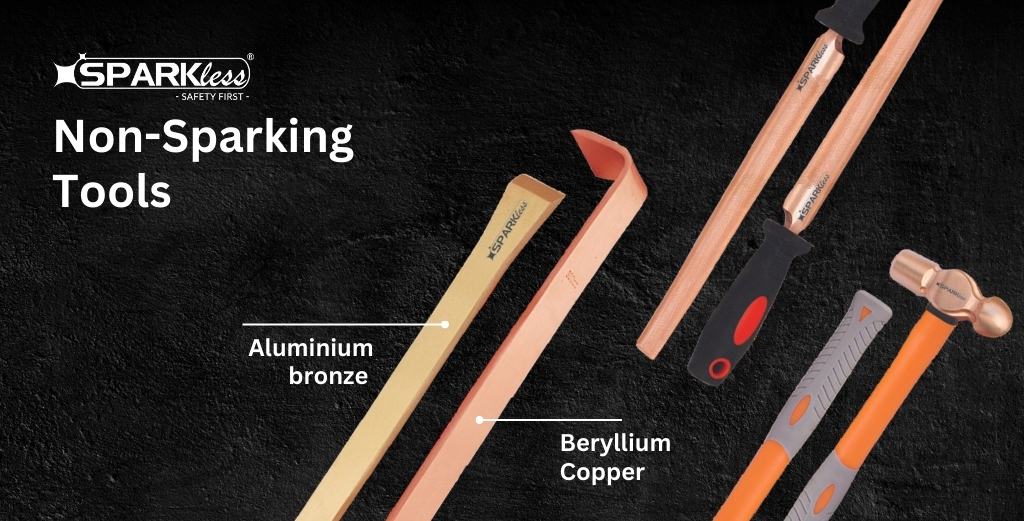
a. Common non-ferrous metals
Non-sparking tools are typically made from Copper alloys, which are less likely to generate sparks during use. Some of the most commonly used alloys in non-sparking tool construction include:
- Brass: An alloy of copper and zinc, brass is widely used in non-sparking tools due to its excellent corrosion resistance, machinability, and relatively low cost.
- Bronze: Composed primarily of copper and tin, bronze is known for its strength, wear resistance, and ability to withstand harsh environments. It is often used in non-sparking tools intended for heavy-duty applications.
- Copper-nickel alloys: These alloys, such as Monel and Cupro-Nickel, offer exceptional corrosion resistance and strength, making them suitable for use in non-sparking tools designed for highly corrosive environments.
- Beryllium copper: While more expensive, beryllium copper alloys are valued for their high strength, hardness, and non-magnetic properties, making them ideal for certain specialized non-sparking tool applications.
b. Properties of each material (tensile strength, wear resistance, etc.)
Each of these non-ferrous metals possesses unique properties that make them suitable for different applications and working conditions:
More information on tensile strength
c. Advantages and disadvantages of different materials
Each material has its own advantages and disadvantages, which should be considered when selecting the appropriate non-sparking tools for a specific application:
- Brass: Advantages include low cost, good machinability, and excellent corrosion resistance. Disadvantages may include lower strength and wear resistance compared to other non-ferrous metals. It is not recommended as an appropriate material for non-sparking tools
- Bronze: Advantages include high strength, excellent wear resistance, and good corrosion resistance. Disadvantages may include higher cost and weight compared to some other options. Certain grades of this alloy such as Aluminium Bronze are suitable for manufacturing non-sparking tools as they have the strength and durability
- Copper-Nickel alloys: Advantages include exceptional corrosion resistance, high strength, and good temperature resistance. Disadvantages may include higher costs and potential health concerns associated with nickel exposure.
- Beryllium Copper: Advantages include very high strength, hardness, and non-magnetic properties. One of the strongest alloys of Copper this alloy is very effective as non-sparking tools in Industrial environments. Disadvantages include higher cost.
Download guide on working with Copper and Copper alloys
d. Non-metal options (wood, leather, plastic)
In addition to non-ferrous metals, non-sparking tools can also be made from non-metallic materials such as wood, leather, or certain types of plastics. These materials can be useful in specific applications where the risk of sparks is minimal, or where non-conductive properties are required.
However, it's important to note that non-metallic materials may have limitations in terms of strength, durability, and resistance to harsh environments, making them less suitable for heavy-duty or demanding applications.
By understanding the different materials used in non-sparking tools and their respective properties, users can make informed decisions about which tools are most appropriate for their specific working conditions and safety requirements.
3. Why Use Non-Sparking Tools?
The use of non-sparking tools is critically important in environments where flammable substances, vapors, or gases are present. In this section, we'll explore the potential hazards of using regular steel tools and highlight the industries and applications where non-sparking tools are essential.
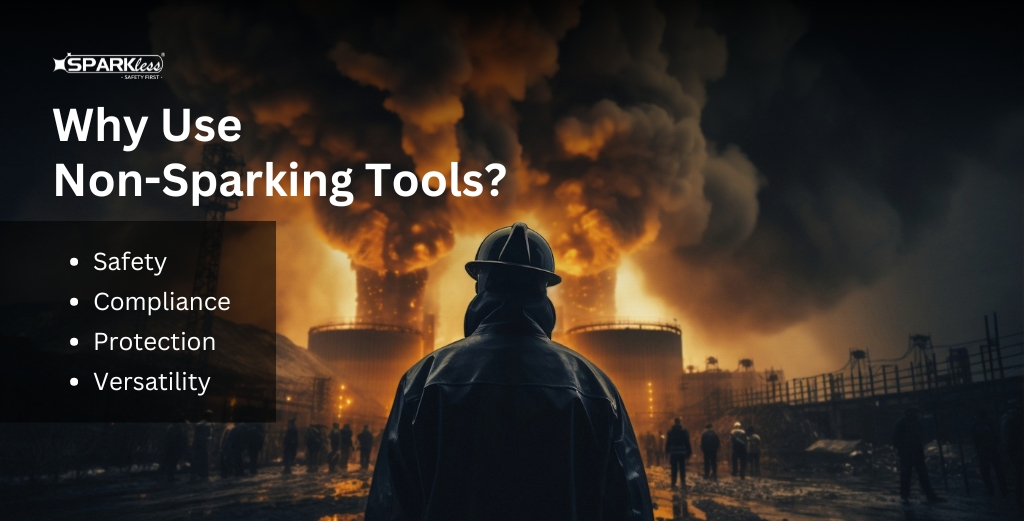
a. Importance in environments with flammable substances
In areas where flammable materials, such as gasoline, solvents, or explosive gases, are present, the risk of ignition and subsequent fires or explosions is significantly higher. Even a small spark generated by regular steel tools can potentially ignite these substances, leading to catastrophic consequences.
Non-sparking tools are designed to minimize the likelihood of producing sparks during normal use, reducing the risk of ignition and ensuring a safer working environment for personnel and equipment.
b. Hazards of regular steel tools (sparks, ignition risks)
When regular steel tools are used in hazardous environments, they pose a significant risk of generating sparks. These sparks can occur due to various factors, including:
- Impact: When a steel tool strikes against another metal surface or object, the impact can create hot sparks capable of igniting flammable materials.
- Friction: The friction generated by the rubbing or scraping of steel tools against other surfaces can also produce sparks, even at relatively low speeds or forces.
- Grinding or cutting: Operations involving grinding, cutting, or other processes that generate heat and friction are particularly hazardous when using regular steel tools in the presence of flammable substances.
These sparks, even if small, can easily ignite flammable gases, vapors, or combustible materials, leading to fires, explosions, and potential loss of life or property damage.
c. Examples of must-use applications (oil rigs, refineries, chemical plants)
Non-sparking tools are essential in industries and applications where flammable substances are commonly present, such as:
- Oil and Gas Industry: Oil rigs, offshore platforms, and refineries are prime examples of environments where the use of non-sparking tools is mandatory. The presence of flammable hydrocarbons and explosive gases necessitates the use of specialized equipment to prevent ignition.
- Chemical Plants: Many chemical processes involve the use or production of flammable chemicals, solvents, or gases. Non-sparking tools are crucial in these facilities to ensure the safety of workers and protect against potential disasters.
- Fertilizers & Petrochem: Both these industries process and handle large quantities of flammable materials, such as ammonia, natural gas, and other petroleum products. The use of non-sparking tools is a critical safety measure in these high-risk environments.
- Pharmaceutical and Biotech Industries: Certain pharmaceutical and biotechnology processes may involve the use of flammable solvents or gases, making non-sparking tools a necessity for safe operations.
- Grain Handling and Processing Facilities: The presence of combustible dust in grain handling and processing facilities can create potentially explosive atmospheres, necessitating the use of non-sparking tools to prevent ignition.
4. Safety Considerations
While non-sparking tools are designed to minimize the risk of generating sparks, it's important to understand that they are not entirely spark-proof under all conditions. In this section, we'll discuss the potential for cold sparks, health risks associated with certain materials, and guidelines for proper use and maintenance.
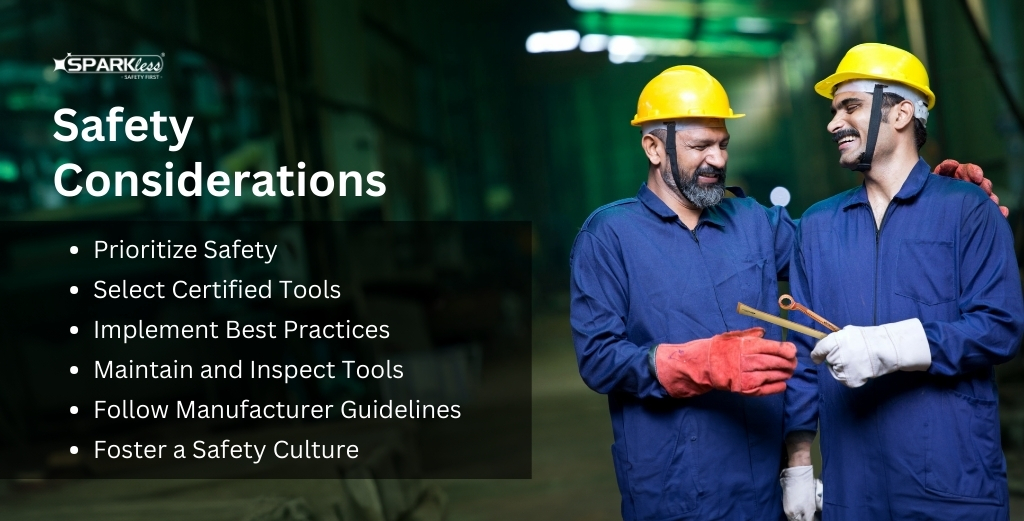
a. Non-sparking tools can still produce cold sparks
Even though non-sparking tools are constructed from non-ferrous metals or non-metallic materials, they can still produce cold sparks under certain circumstances. Cold sparks are typically less energetic than the hot sparks generated by regular steel tools and usually do not pose much threat due to their lower temperature.
Hot sparks can still occur with non-sparking tools due to factors such as:
- High-speed impacts: When non-sparking tools are subjected to high-velocity impacts or collisions, the kinetic energy can be sufficient to generate cold sparks.
- Excessive force: Applying excessive force or torque during the use of non-sparking tools can lead to material deformation and the production of cold sparks.
- Improper use or maintenance: Misuse or lack of proper maintenance can cause damage or wear to non-sparking tools, increasing the likelihood of cold sparks during operation.
It's crucial to understand that while non-sparking tools are designed to reduce the risk of sparks, they are not entirely spark-proof under all conditions. Proper training, adherence to safety protocols, and regular maintenance are essential to minimize the potential for cold sparks and ensure the safe use of these tools.
b. Guidelines for proper use and maintenance
To ensure the safe and effective use of non-sparking tools, it's essential to follow proper guidelines for their use and maintenance:
- Training: Provide comprehensive training to workers on the appropriate use of non-sparking tools, safety protocols, and potential hazards associated with their work environment.
- Inspection: Regularly inspect non-sparking tools for signs of wear, damage, or deformation that could increase the risk of sparks or tool failure.
- Cleaning: Keep non-sparking tools clean and free from debris, as accumulated materials can increase the likelihood of sparks or tool malfunction.
- Proper storage: Store non-sparking tools in designated areas, protected from potential damage or contamination.
- Replacement: Replace worn or damaged non-sparking tools promptly, as continuing to use them can increase the risk of sparks or tool failure.
- Follow manufacturer guidelines: Always refer to the manufacturer's instructions for the proper use, maintenance, and care of specific non-sparking tools.
By adhering to these guidelines and implementing a comprehensive safety program, companies can ensure the safe and effective use of non-sparking tools, minimizing the risk of accidents and protecting their personnel, assets, and operations.
5. Standards and Certifications
Various industry standards and certifications have been established to ensure the safety and effectiveness of non-sparking tools. This section will explore some of the major standards and highlight the importance of using certified tools in hazardous environments.
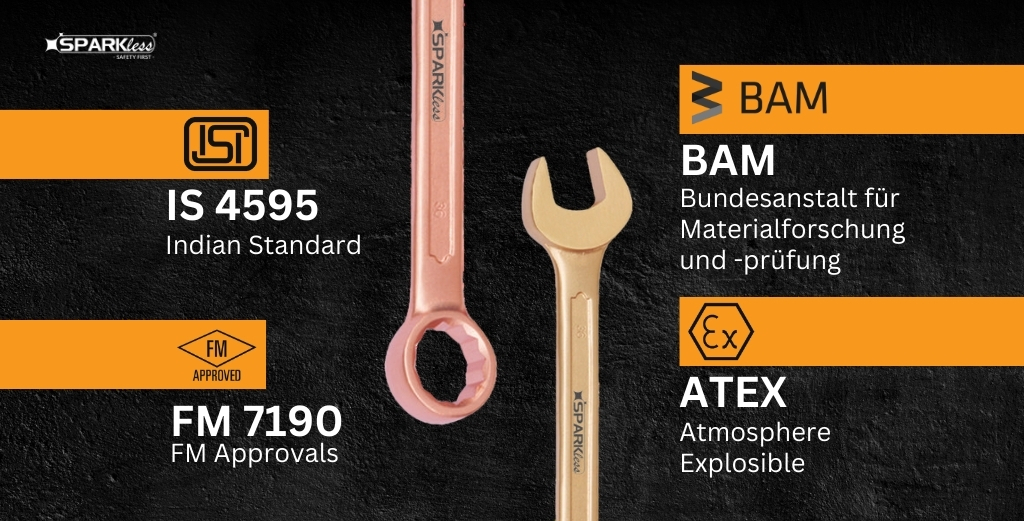
a. Major standards for non-sparking certification (IS 4595, FM 7190, BAM)
Several organizations and agencies have developed standards and testing protocols for certifying non-sparking tools. Some of the most widely recognized standards include:
- IS 4595 (Indian Standard): This standard, established by the Bureau of Indian Standards (BIS), specifies the requirements for non-sparking tools intended for use in potentially explosive atmospheres. It covers materials, design, and testing criteria.
- FM 7190 (FM Approvals): FM Approvals, a globally recognized third-party certification organization, has developed the FM 7190 standard for non-sparking tools. This standard outlines the requirements for materials, construction, and performance testing to ensure the tools are suitable for use in hazardous locations.
- BAM (Bundesanstalt für Materialforschung und -prüfung): The German Federal Institute for Materials Research and Testing (BAM) has established guidelines and certification processes for non-sparking tools used in potentially explosive atmospheres. BAM certification is widely recognized in various industries.
- ATEX (Atmosphere Explosible): The ATEX directive is a European Union (EU) regulation that governs the use of equipment in potentially explosive atmospheres. Non-sparking tools do not fall under the ATEX scope as it has no known sources of ignition. Having said that ATEX zones classification provides guidance to end users on where non-sparking tools should be used.
These standards and certifications ensure that non-sparking tools meet specific criteria for materials, design, and performance, minimizing the risk of generating sparks or other potential hazards in hazardous environments.
b. Importance of using certified tools
Using certified non-sparking tools that comply with recognized standards is crucial for several reasons:
- Safety: Certified tools have undergone rigorous testing and evaluation to verify their ability to minimize the risk of sparks and ensure safe operation in hazardous environments. Using non-certified tools can put workers and facilities at risk.
- Regulatory Compliance: Many industries and jurisdictions have regulations and laws that mandate the use of certified non-sparking tools in certain environments. Failure to comply with these regulations can result in fines, penalties, or legal consequences.
- Quality Assurance: Certified tools are manufactured to meet strict quality standards, ensuring consistent performance and reliability. Non-certified tools may vary in quality and may not offer the same level of protection or durability.
- Liability Protection: By using certified non-sparking tools, companies can demonstrate due diligence in ensuring the safety of their operations and personnel. This can help mitigate potential liabilities in the event of an incident.
- Insurance Requirements: Some insurance providers may require the use of certified non-sparking tools in hazardous environments as a condition of coverage, reducing the risk of claims and potential losses.
When selecting non-sparking tools for use in hazardous environments, it is essential to choose tools that are certified by reputable organizations and comply with the relevant industry standards. This proactive approach to safety can significantly reduce the risk of incidents and ensure the protection of workers, facilities, and operations.
6. Proper Use and Maintenance
To ensure the safe and effective use of non-sparking tools, proper handling, maintenance, and storage practices are essential. In this section, we'll provide guidelines for the safe and appropriate use of these tools, as well as procedures for cleaning, sharpening, and storing them properly.
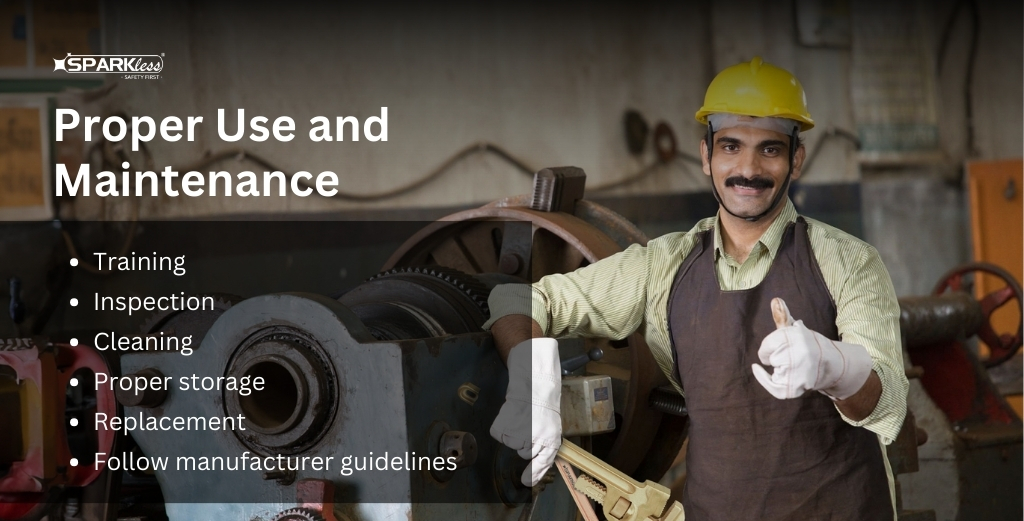
a. Guidelines for safe and effective use
When working with non-sparking tools in hazardous environments, it's crucial to follow these guidelines for safe and effective use:
- Training: All personnel should receive comprehensive training on the proper use, limitations, and safety protocols associated with non-sparking tools.
- Inspection: Before each use, thoroughly inspect non-sparking tools for signs of damage, wear, or deformation that could compromise their effectiveness or safety.
- Proper Selection: Choose the appropriate non-sparking tool for the task at hand, considering factors such as the material compatibility, tool strength, and the specific hazards present in the work environment.
- Avoid Excessive Force: Do not apply excessive force or torque when using non-sparking tools, as this can lead to material deformation and increase the risk of generating sparks or tool failure.
- Maintain Control: Always maintain control and a secure grip on non-sparking tools during use to prevent slips, drops, or unintended impacts that could generate sparks or damage the tools.
- Observe Safe Work Practices: Follow all established safe work practices, such as wearing appropriate personal protective equipment (PPE), maintaining good housekeeping, and adhering to safety protocols specific to the work environment.
- Report Issues: If a non-sparking tool becomes damaged or compromised in any way, immediately remove it from service and report the issue to supervisors or safety personnel.
b. Cleaning and inspection procedures
Regular cleaning and inspection are essential for maintaining the integrity and effectiveness of non-sparking tools. Follow these procedures:
- Cleaning: After each use, thoroughly clean non-sparking tools to remove any debris, oil, or contaminants that could potentially increase the risk of sparks or tool malfunction.
- Inspection: Carefully inspect non-sparking tools for signs of wear, cracks, deformation, or other damage that could compromise their performance or safety.
- Documentation: Maintain detailed records of inspections, cleaning, and any issues or repairs performed on non-sparking tools for traceability and compliance purposes.
- Replacement: Replace any non-sparking tools that show significant wear, damage, or deformation, as continuing to use them could pose a safety risk.
c. Tool sharpening/redressing methods
Over time, non-sparking tools may become dull or require sharpening or redressing to maintain their effectiveness. Follow these guidelines:
- Manufacturer Instructions: Always refer to the manufacturer's instructions for specific sharpening or redressing methods for each type of non-sparking tool.
- Trained Personnel: Ensure that only trained and qualified personnel perform sharpening or redressing operations on non-sparking tools.
- Inspection After Sharpening: Thoroughly inspect non-sparking tools after sharpening or redressing for any signs of damage, deformation, or potential compromise to their non-sparking properties.
d. Proper storage and disposal
Proper storage and disposal practices are essential for maintaining the integrity and safety of non-sparking tools:
- Storage: Store non-sparking tools in designated areas, protected from potential damage, contamination, or exposure to harsh environments.
- Segregation: Keep non-sparking tools segregated from regular steel tools to prevent inadvertent mixing or misuse.
- Labeling: Clearly label storage areas and containers for non-sparking tools to ensure proper identification and prevent confusion.
- Disposal: When non-sparking tools reach the end of their service life or become damaged beyond repair, dispose of them following established procedures and regulations to prevent potential misuse or environmental contamination.
7. Comparison with Other Safety Tools
While non-sparking tools are designed to minimize the risk of sparks in hazardous environments, they are not the only type of specialized safety equipment used in various industries. In this section, we'll differentiate non-sparking tools from insulated tools used for electrical safety and compare them with explosion-proof equipment and their respective applications.
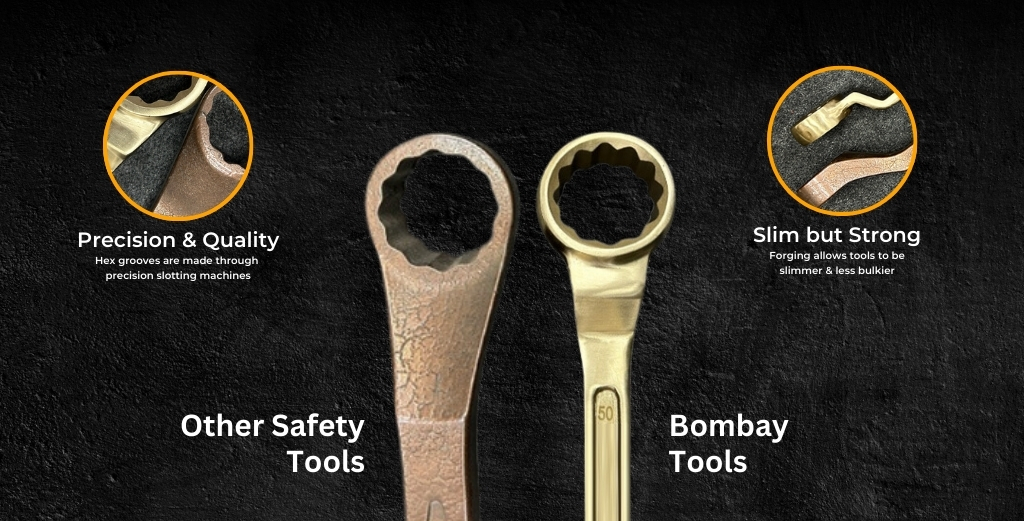
a. Differentiate from insulated tools (used for electrical safety)
Insulated tools, also known as electrically insulated tools or live-line tools, are designed to protect workers from electrical hazards, such as electric shocks or arc flashes, when working on or near energized electrical systems. These tools are typically made of materials with high dielectric strength, such as fiberglass-reinforced plastic, PVC, rubber, or other non-conductive materials.
In contrast, non-sparking tools are primarily intended to prevent the ignition of flammable substances, vapors, or gases in hazardous environments. They are constructed from non-ferrous metals or non-metallic materials that are less likely to generate sparks during use, minimizing the risk of igniting explosive atmospheres.
While insulated tools are designed to protect against electrical hazards, they may not necessarily be suitable for use in environments with flammable substances, as they can still generate sparks if made from ferrous materials or if used improperly. Conversely, non-sparking tools are not specifically designed for electrical safety and should not be used for work on energized electrical systems.
It's important to understand the different purposes and applications of these specialized tools and to use the appropriate equipment for the specific hazards present in the work environment.
b. Compare with explosion-proof equipment and their applications
In addition to non-sparking tools, another type of specialized equipment used in hazardous environments is explosion-proof equipment. Explosion-proof equipment is designed to contain and control potential explosions within its enclosure, preventing the ignition of surrounding flammable atmospheres.
The major difference between explosion-proof equipment and non-sparking tools is that the former can and does generate sparks (or internal explosions) whereas hand tools do not have their own source of ignition.
Non-sparking tools and explosion-proof equipment are often used in conjunction to provide a comprehensive approach to safety in hazardous environments. Non-sparking tools may be used within explosion-proof enclosures or in areas adjacent to them, depending on the specific hazards and risk assessments.
It's essential to understand the distinction between these types of safety equipment and to follow industry best practices and regulations when selecting and using the appropriate equipment for a given application and work environment.
By differentiating non-sparking tools from other types of safety equipment and understanding their respective applications, companies can implement a comprehensive safety strategy that addresses various hazards and minimizes the risk of incidents in hazardous environments.
8. Best Practices and Safety Protocols
Working in environments where flammable substances are present requires strict adherence to best practices and safety protocols to ensure the protection of personnel, assets, and operations. In this section, we'll outline safe work procedures, discuss the role of ventilation, isolation, and purging, and emphasize the importance of following manufacturer guidelines.
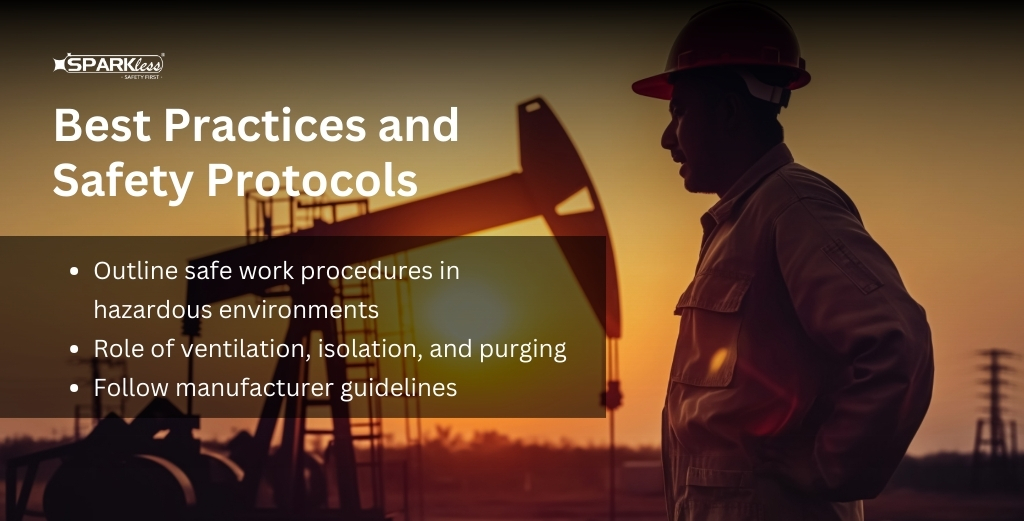
a. Outline safe work procedures in hazardous environments
Implementing and following safe work procedures is crucial when operating in hazardous environments. These procedures should include, but are not limited to:
- Risk Assessment: Conduct thorough risk assessments to identify potential hazards, evaluate the likelihood and severity of incidents, and implement appropriate control measures.
- Permit-to-Work System: Implement a permit-to-work system that requires authorization and documentation for all work activities in hazardous areas, ensuring proper safety measures are in place.
- Hot Work Permits: Obtain and follow hot work permits for any activities that involve potential sources of ignition, such as welding, grinding, or cutting operations.
- Personal Protective Equipment (PPE): Ensure that all personnel wear appropriate PPE, such as fire-resistant clothing, safety glasses, and respiratory protection, based on the specific hazards present.
- Tool Inspection and Selection: Conduct pre-use inspections of non-sparking tools and select the appropriate tools for the task and work environment.
- Hazardous Area Classification: Clearly identify and demarcate hazardous areas based on the type and concentration of flammable substances present.
- Emergency Response Planning: Develop and regularly review emergency response plans, including evacuation procedures, firefighting equipment, and communication protocols.
- Training and Competency: Ensure that all personnel involved in hazardous work activities receive comprehensive training on safe work procedures, hazard recognition, and the proper use of non-sparking tools and other safety equipment.
- Incident Reporting and Investigation: Implement robust incident reporting and investigation processes to identify root causes, implement corrective actions, and prevent future occurrences.
b. Role of ventilation, isolation, and purging
In addition to safe work procedures, proper ventilation, isolation, and purging techniques play a crucial role in mitigating hazards and ensuring safe operations in environments with flammable substances. These measures include:
- Ventilation: Adequate ventilation systems should be in place to remove or dilute flammable gases, vapors, or dusts to safe levels, reducing the risk of ignition.
- Isolation: Isolating hazardous areas by physically separating them from non-hazardous areas can prevent the spread of flammable substances and contain potential incidents.
- Purging: Purging techniques, such as introducing inert gases or displacing flammable substances with non-flammable materials, can reduce the concentration of flammable substances to safe levels before work activities commence.
- Monitoring: Continuous monitoring of gas, vapor, or dust levels using appropriate detection equipment is essential to ensure that concentrations remain within safe limits during work activities.
- Control of Ignition Sources: Strict control measures should be in place to eliminate potential ignition sources, such as open flames, hot surfaces, or static electricity, in hazardous areas.
c. Follow manufacturer guidelines
When working with non-sparking tools, it is crucial to follow the manufacturer's guidelines and instructions for their proper use, maintenance, and care. These guidelines often include specific recommendations for:
- Intended Use: Understanding the intended use and limitations of each non-sparking tool, including the materials and environments for which they are designed.
- Inspection and Maintenance: Following prescribed inspection and maintenance procedures to ensure the tools remain in optimal condition and free from damage or wear that could compromise their safety.
- Sharpening and Redressing: Adhering to specific methods and guidelines for sharpening or redressing non-sparking tools to maintain their effectiveness and non-sparking properties.
- Storage and Handling: Properly storing and handling non-sparking tools to prevent damage, contamination, or exposure to conditions that could degrade their performance or safety.
- Replacement and Disposal: Understanding when non-sparking tools should be replaced due to excessive wear or damage, and following proper disposal procedures to prevent misuse or environmental contamination.
- Safety Precautions: Reviewing and adhering to all safety precautions and warnings provided by the manufacturer, including the use of personal protective equipment (PPE) and other safety measures specific to the tools or work environment.
By following the manufacturer's guidelines and recommendations, companies can ensure that non-sparking tools are used correctly, maintained properly, and replaced when necessary, maximizing their effectiveness and minimizing the risk of incidents in hazardous environments.
Conclusion
Working in environments where flammable substances are present poses significant risks and demands a comprehensive approach to safety. The use of non-sparking tools is a critical element in mitigating these risks and ensuring the protection of personnel, assets, and operations.
Throughout this guide, we have explored the importance of non-sparking tools, the materials used in their construction, the potential hazards associated with regular steel tools, and the industries and applications where non-sparking tools are essential. We have also discussed safety considerations, industry standards and certifications, and best practices for the proper use, maintenance, and storage of these specialized tools.
By understanding the key points and following the guidelines outlined in this guide, companies can implement effective safety strategies and create a culture of safety that prioritizes the well-being of their employees and the integrity of their operations.

